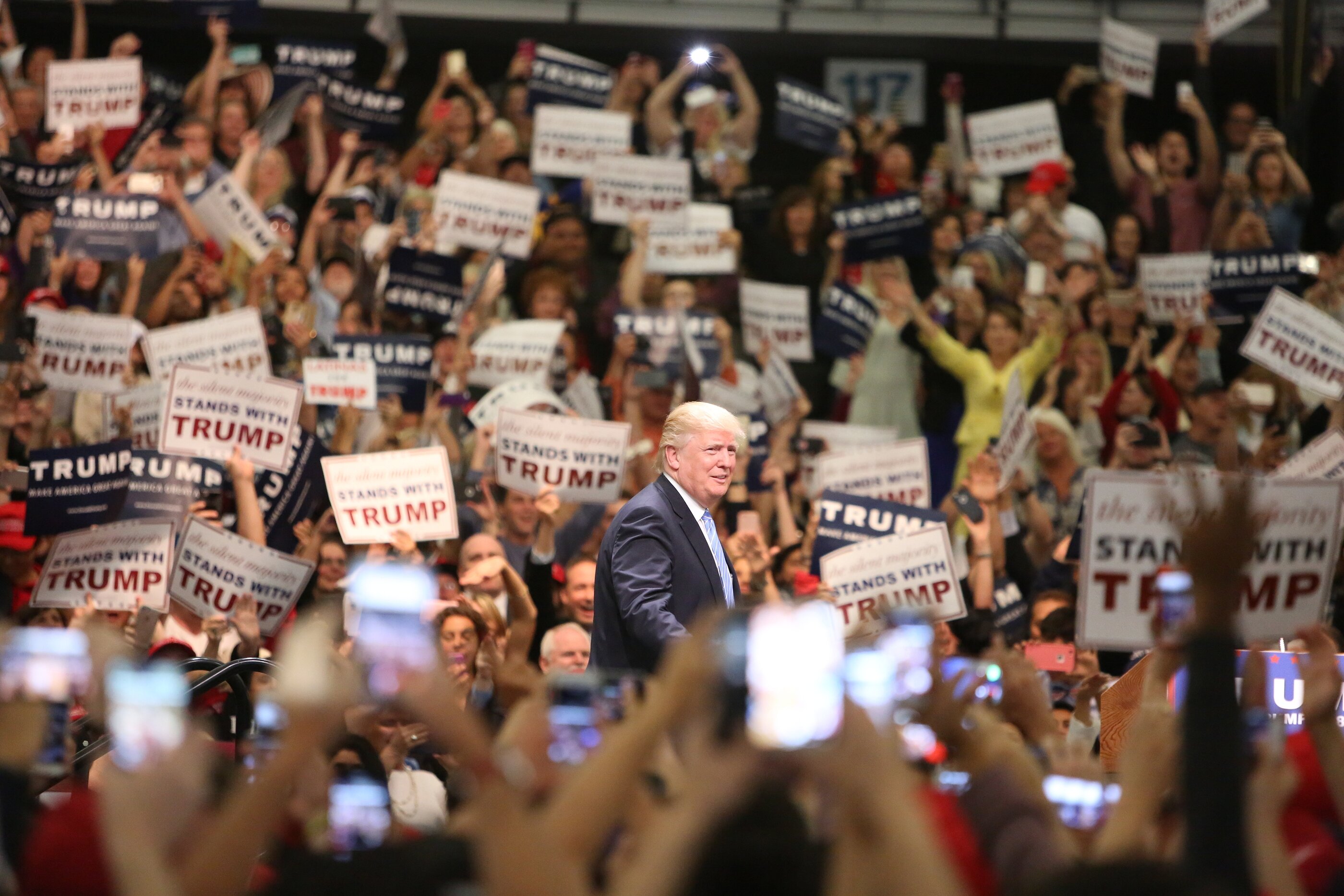The Official RNC Round Up

The GOP held their presidential convention, the Republican National Convention (RNC), at the Quicken Loans Stadium in Cleveland, Ohio from July 18th-21st.
For four days, state delegates, party officials, elected politicians, celebrities, and guests from all fifty states and the US territories gathered to officially nominate the GOP’s candidates for President and Vice President of the United States, and showcase the Republican platform. This was however, far from a normal RNC.
After an unconventional primary campaign, won in an unconventional manner, what else could we expect at the RNC from the nominee ascendant, Donald Trump, other than an unconventional convention. Here we’ll break down the four days, each named with a take on Trump’s slogan “Make America Great Again,” and offer some take-away analysis of the 2016 RNC.
Day 1 – Make America Safe Again
Before any of the scheduled speakers could take the stage, several state delegations had some unfinished business. While Trump was the presumptive nominee, the RNC had yet to actually vote on the nomination. The state primaries only served to elect bound delegates to represent votes at the RNC, and the actual vote wasn’t until the second day of the RNC. That was ample time for the delegates to voice a few of their…concerns.
A total of nine state delegations submitted a request for a roll call vote to the RNC Chair, with the intention of forcing all the delegates at the RNC to have a recorded vote on a convention rules package that would lead to an unbinding of all delegates to “vote their conscience.”
Sounds convoluted? It gets better.
Following the submission of the requests, three state delegation requests were invalidated for undisclosed reasons, dropping the total state delegation count below the eight state delegation threshold needed for a roll call vote request. This was effectively the last attempt by the #NeverTrump movement to oppose the nomination of Trump, and it was killed by the RNC leaders. Two state delegations walked out in protest, and a sizable faction of delegates continued to vocally protest over the course of the day.
The remainder of the day was devoted towards showcasing Trump’s plans to make America safe again, or at least that was the intention. Many of the speakers, including Sen. Tom Cotton (R-AR), Sen. Jeff Sessions (R-AL), former New York City Mayor Rudy Giuliani, and retired Lt. General Michael Flynn spent time lambasting the Obama Administration’s foreign policy, pinning the blame squarely on Hillary Clinton. Chants of “USA!” broke out as the speakers heralded a new Trump-led era of victory over ISIS and all of America’s enemies. The speeches were light on actual policy details, but to the audience the anger-laden rhetoric more than made up for it.
Trump also had a mother of a Benghazi victim speak, and while it was an emotional speech, Trump oddly decided to force most major networks to turn their feeds away from the RNC to the Golf Channel, where he made an appearance in the middle of the mother’s speech.
Trump’s media cycle was ruined after his wife, Melania, gave her speech supporting Trump however, when it was discovered that Melania had plagiarized sections of her speech from First Lady Michelle Obama’s 2008 DNC speech. Instead of a focus on the tirades against Hillary’s failures as Secretary of State, the media blasted the plagiarism scandal across networks and the internet, leading to the creation of #MelaniaTrumpFamousQuotes.
Not even Trump’s grandiose entrance to the RNC to introduce Melania helped to dull the media firestorm.
Day 2 – Make America Work Again
The delegates voted for the official nomination, and without any major issues, Trump was placed right at the top of the GOP ticket.
While ostensibly about the GOP’s economic platform points, many of the speeches devolved into a rehash of Day 1 and an impromptu “indictment” of Hillary. Speaker of the House Paul Ryan (R-WI) and Senate Majority Leader Mitch McConnell made pleas for party unity, trying to gloss over some of the more unsavory elements of Trump’s campaign. That devolved after New Jersey Governor Chris Christie took the stage and led a mob-fueled de facto “indictment” of Hillary, effectively charging that Hillary should be locked up for holding policy viewpoints that differed from his. Massive chants of “Lock her up!” broke out, quickly becoming a new mainstay for the angry Trump base.
Two of Trump’s children spoke, and Dr. Ben Carson somehow found his way onto the stage to give another drowsing talk on his support for Trump while linking Hillary to a supposed devil worshiper and setting off another controversy.
Day 3 – Make America First Again
The speeches were a lot more on theme on Day 3, and the capstone was supposed to be the speech by the VP nominee, Indiana Governor Mike Pence. Pence gave a solid speech, designed to sell the presidential ticket to the voters and showcase his oratory skills. The problem was that a couple speeches before, Senator Ted Cruz (R-TX) decided that he would pointedly not include an endorsement of Trump in his speech, instead opting to tell all those listening to “vote your conscience.” The audience tried to drown Cruz in boos when they realized what he was doing.
Once again, Trump lost complete control over the media cycle, helped along by Cruz taking to the news networks the next morning to reiterate in clear terms that he was absolutely refusing to back Trump.
Day 4 – Make America One Again
Possibly one of the more remarkable things to happen at this RNC, and really any past RNCs included, was that the openly gay, billionaire Peter Thiel had a prime time speaking spot. While he spent most of his speech praising Trump, he also took the time to point out Trump’s support and acceptance for LGBTQ individuals, eliciting cheers from the audience. This was the first ever time anyone had cheered for LGBTQ at an RNC, but it was muddied by one of the most anti-LGBTQ platforms ever proposed by the GOP.
Trump’s favorite kid, Ivanka Trump, introduced her father and in all honesty, it was an astoundingly charismatic speech. It was heartfelt, laden with annecdotes, buoyed by policy statements, and delivered with an oratory skill that will make Ivanka a threat to anyone she chooses to run against if she enters politics. Although, a few of her policy points sounded suspiciously like Democrat policies. There must’ve been a decent amount of cognitive dissonance that evening.
Finally, Donald Trump, the man himself, took the stage to give his nomination acceptance speech and to lay out his biggest appeal to the voters yet.
If anyone was still expecting Trump to make any kind of moderate pivot for the general election, that all died in this speech. Trump tripled down on his populist, strongman policies, painting a bleak picture of America’s present, denouncing multilateral trade deals and the wars in the Middle East, claiming lawlessness and chaos in America, pointing to threats from illegal immigrants and refugees and terrorists, showing how weak America has become under Obama and Hillary. He cemented his break with GOP orthodoxy, casting aside free trade ideals and neoconservative foreign policy and neglecting to mention any social conservative issues.
Trump’s speech was the longest RNC speech in decades, and he ended his tirade of fear by claiming that he alone could save America. His rhetoric was exceptionally dark and there’s no mistaking that the GOP is no longer the Reagan party, but is now firmly the Trump party.
Take-aways from the 2016 RNC
The conclusion of the RNC symbolizes the introduction of the GOP to the electorate for the general election come November. After the RNC there is roughly 100 or so days for the GOP to campaign across America in order to sell the message they presented at the RNC. Here are a few of my take-aways as we enter the general election.
1. The GOP remains fractured in many aspects.
None of the former GOP presidents or nominees have endorsed Trump, nor are they planning to. Ted Cruz, a popular leader of the Tea Party base of the GOP, dramatically refused to bow to Trump. Several Senators and Representatives have made it clear that they will never vote for Trump. Most of the party leadership has stated that they will vote for Trump, but still remain on the fence about giving a full-throated endorsement of Trump and his campaign. Moderate Republicans and social conservatives alike continue to take issue with many of Trump’s stances, and repeated gaffes by Trump and his campaign continue to blow up his media presence. This was on display on the RNC when many prominent Republicans declined to attend or speak at the convention, including Presidents H.W. Bush and W. Bush. How much of this matters to the voter base remains to be seen (voters could quickly coalesce around Trump regardless of all the issues we see with party unity), but the overall picture of the GOP shows a not insignificant amount of disunity.
2. Trump is betting on selling himself as a populist strongman who will save America.
Trump’s nomination speech reaffirmed what he’s been building up throughout the primaries. His core policies revolve around “law and order,” dealing with perceived threats from illegal immigrants and refugees, terrorists like ISIS, eliminating trade deals and reintroducing tariffs to protect domestic businesses, and protecting low-wage Americans and cops. He has chosen to rely on rhetoric that claims that America is dark and terrifying, and has positioned himself as the singular being who can bring greatness back to America. It’s a huge gamble entirely dependent on voters’ perceptions about the economy and national security.
3. The GOP is entirely dependent on Trump to keep their majorities in the Senate and the House of Representatives. But they still refuse to embrace all of Trump’s policies and rhetoric.
Downballot politicians rely on the top of the party ticket to draw out enough voters in order to ensure they either keep their seats or win new ones. This means that a lot of party elites will continually find themselves in a balancing act, having to carefully gauge how they present their support for the volatile Trump. A full embrace might pay off if Trump wins, but will hurt if Trump loses and all their reputations are tied to Trump for attacks in future elections. Not enough support for Trump risks turning off voters and costing the GOP numerous critical elections. Too much support for Trump also risks turning off voters. There’s no easy path for GOP politicians to take, and the 2016 election is proving to be the GOP’s biggest challenge to date.
4. There is no reset button left to push for the GOP.
What happens now and until November will matter a lot. The primaries and the RNC both serve as backup reset buttons that allow the GOP to change their platform, have candidates change or adjust their image, improve campaigns, take pauses to build up party infrastructure, all important things that allow the party to take a breather and push forward into the general. Now however, all that is in the past. There are roughly 100 days to win a general election, and every action is either a step forward or a step backward. Any scandal or gaffe will be magnified, and that effect will only increase as we draw close to the official presidential debates and finally election day itself. Trump is embroiled in controversy on a semi-regular basis, mainly by his own doing, and that is a very risky thing to continue into these last few months. So far he has shown no signs of stopping, so the GOP should buckle up for what will likely be a rough general campaign. Again all this might not matter to the voters who might turnout for Trump anyways, but the voter coalition that Trump is targeting is one that has not been put together before. Only time will tell how it all plays out for the GOP.
The GOP has chosen their Presidential and Vice Presidential nominees, Donald Trump and Mike Pence, respectively. Now we will see how their gamble pays off.









